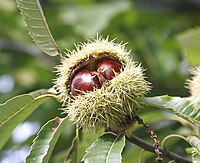
Does the persistence of sweet chestnut depend on cultural inputs? Regeneration, recruitment, and mortality in Quercus- and Castanea-dominated forests
Sign Up to like & getrecommendations! Published in 2018 at "Annals of Forest Science"
DOI: 10.1007/s13595-018-0772-0
Abstract: Key messageQuercussecondary forests show a gradual transition toward mixed forests, with sweet chestnut (Castanea sativa) becoming increasingly abundant in the western Spanish Central System. Additionally, in chestnut-dominated stands, it shows a certain resistance to competitive… read more here.
Keywords: cultural inputs; regeneration; castanea; sweet chestnut ... See more keywords

Revising the sweet chestnut (Castanea sativa Mill.) refugia history of the last glacial period with extended pollen and macrofossil evidence
Sign Up to like & getrecommendations! Published in 2019 at "Quaternary Science Reviews"
DOI: 10.1016/j.quascirev.2019.01.002
Abstract: Abstract Recent advances in palaeoecology provide growing evidence of complex spatio-temporal patterns of tree species survival during the last glaciation. The distribution of Sweet chestnut (Castanea sativa Mill.) glacial refugia is still controversial. For this… read more here.
Keywords: castanea; sweet chestnut; chestnut; castanea sativa ... See more keywords

First report of Gnomoniopsis smithogilvyi causing chestnut brown rot on nuts and burrs of sweet chestnut in Spain.
Sign Up to like & getrecommendations! Published in 2022 at "Plant disease"
DOI: 10.1094/pdis-02-22-0322-pdn
Abstract: About 60% of the nut production of sweet chestnut (Castanea sativa Mill.) in Europe originates in Spain (FAOSTAT, 2022), mostly (91%) in Galicia (NW Spain). In September 2021, premature fall of immature chestnut burrs and… read more here.
Keywords: chestnut; brown rot; smithogilvyi; sweet chestnut ... See more keywords

Biological Control of Cryphonectria parasitica in Romanian Protected Sweet Chestnut Forests
Sign Up to like & getrecommendations! Published in 2017 at "Notulae Botanicae Horti Agrobotanici Cluj-napoca"
DOI: 10.15835/nbha45210895
Abstract: Asiatic fungus Cryphonectria parasitica has gradually infected all chestnut habitats, forest and horticulture plantations from the most important natural centres of sweet chestnut distribution in Romania. The objectives of this work were to understand the… read more here.
Keywords: chestnut; control; biological control; cryphonectria parasitica ... See more keywords

Long-term oral administration of sweet chestnut (Castanea sativa Mill.) extract does not affect the contraction ability of isolated ileum
Sign Up to like & getrecommendations! Published in 2019 at "Acta Veterinaria Brno"
DOI: 10.2754/avb201988020219
Abstract: Extracts of sweet chestnut (Castanea sativa Mill.) which contain hydrolysable tannins are used to prevent diarrhoea in farm animals due to the astringent effect of tannins. The aim of this study was to establish whether… read more here.
Keywords: term; long term; castanea sativa; sweet chestnut ... See more keywords

Sweet Chestnut (Castanea sativa Mill.) Nutritional and Phenolic Composition Interactions with Chestnut Flavor Physiology
Sign Up to like & getrecommendations! Published in 2022 at "Foods"
DOI: 10.3390/foods11244052
Abstract: The European chestnut (Castanea sativa Mill.), is an environmentally and economically important species in Europe, mainly for fruit production. The chestnut fruit is well-known for its nutritional properties, namely its high concentration of carbohydrates (starch)… read more here.
Keywords: chestnut; sweet chestnut; sativa mill; physiology ... See more keywords

Sweet chestnut agroforestry systems in North-western Spain: Classification, spatial distribution and an ecosystem services assessment
Sign Up to like & getrecommendations! Published in 2018 at "Forest Systems"
DOI: 10.5424/fs/2018271-11973
Abstract: Aim of study: Agroforestry systems of Castanea sativa have specific forest structures, which are different from other ecosystems of sweet chestnut. They have provided several ecosystems services (ES) to local inhabitants for centuries including relevant… read more here.
Keywords: north western; agroforestry systems; agroforestry; spatial distribution ... See more keywords